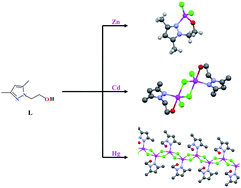Variable behaviour of flexible N,O-mixed pyrazoleligand towards Zn(ii), Cd(ii) and Hg(ii) ions. Synthesis, crystal structure and fluorescent properties†
Abstract
The variable coordination behaviour of the mixed

* Corresponding authors
a
Departament de Química, Facultat de Ciències, Unitat de Química Inorgànica, Universitat Autònoma de Barcelona, Bellaterra-Cerdanyola, Barcelona, Spain
E-mail:
Josefina.Pons@uab.es
Fax: +34 93 581 31 01
b Cristal·lografia, Mineralogia i Dipòsits Minerals, Universitat de Barcelona, Martí i Franquès s/n, Barcelona, Spain
c Institut de Ciència de Materials de Barcelona (CSIC), Campus de la UAB, Bellaterra, Barcelona, Spain
d Departament de Química, Unitat de Química Física, Universitat Autònoma de Barcelona, Bellaterra, Barcelona, Spain
e Nanobioelectronics & Biosensors Group, Institut Català de Nanotechnologia (CIN2, ICN-CSIC), Bellaterra, Barcelona, Spain
The variable coordination behaviour of the mixed

 Please wait while we load your content...
Something went wrong. Try again?
Please wait while we load your content...
Something went wrong. Try again?
M. Guerrero, J. Pons, J. Ros, M. Font-Bardia, O. Vallcorba, J. Rius, V. Branchadell and A. Merkoçi, CrystEngComm, 2011, 13, 6457 DOI: 10.1039/C1CE05626C
To request permission to reproduce material from this article, please go to the Copyright Clearance Center request page.
If you are an author contributing to an RSC publication, you do not need to request permission provided correct acknowledgement is given.
If you are the author of this article, you do not need to request permission to reproduce figures and diagrams provided correct acknowledgement is given. If you want to reproduce the whole article in a third-party publication (excluding your thesis/dissertation for which permission is not required) please go to the Copyright Clearance Center request page.
Read more about how to correctly acknowledge RSC content.
 Fetching data from CrossRef.
Fetching data from CrossRef.
This may take some time to load.
Loading related content
